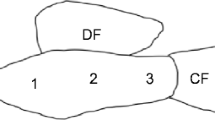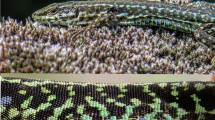Abstract.
Studies on fish have demonstrated female-mating preferences based on dimorphic colours and colour patterns, but commonly focused on the 400–700 nm (visible) band. In experiment 1 we exposed females of the amarillo (Girardinichthys multiradiatus), a viviparous fish with visually based female mate choice, to two views of males either containing (UV+) or lacking (UV–) information in the 300–400 nm region. Experiments were conducted outdoors, and we found that females spent more time next to the male seen through the UV+ filter than the same seen through the UV– filter. Since the two images only differed in the content of UV radiation, we conclude that females of the amarillo can detect UV light. Experiments 2 and 3 were designed to test whether such an effect can be attributed to female preferences based on the males' UV-reflecting colour patterns. We first assessed which area(s) of the fish have UV-reflecting properties. Then, using an opaque gelatine powder to block skin reflectance, we found that, in the presence of environmental UV light, females spend more time close to the males with powder sprinkled outside the UV-reflecting area (control) than to the males with powder sprinkled over the UV-reflecting area (experiment 2). This could have been due to the concealment of signals in the visible spectrum, rather than in the UV spectrum; thus we repeated the same experiment indoors, in the absence of UV light (experiment 2b); here females failed to discriminate between males. Since we also found that females have UV-reflecting areas in their flanks, we conducted a third experiment to test whether the preferential association of females found in the first experiment was due to the tendency to school/associate with conspecifics, rather than to mate choice (experiment 3). We found no evidence of discrimination in this experiment. We conclude that the UV markings and vision in G. multiradiatus have a function in female mate choice. This is the first time that evidence has been found for the influence of UV for mate choice in fish.
Similar content being viewed by others
Author information
Authors and Affiliations
Additional information
Electronic Publication
Rights and permissions
About this article
Cite this article
Macías Garcia, C., de Perera, T. Ultraviolet-based female preferences in a viviparous fish. Behav Ecol Sociobiol 52, 1–6 (2002). https://doi.org/10.1007/s00265-002-0482-2
Received:
Revised:
Accepted:
Issue Date:
DOI: https://doi.org/10.1007/s00265-002-0482-2




